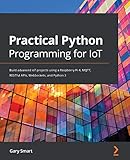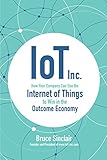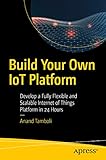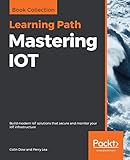The Internet of Things (IoT) directs to a group of connected devices that may communicate through the internet without requiring a human to initiate the communication.
As per the Cisco report, IoT will generate $14.4 trillion in revenue across all endeavors over the next ten years. IoT applications are gradually becoming a significant part of our daily lives.
Are you curious about learning more about the Internet of Things?
Many people are, but finding resources to help them navigate this complex system can be challenging.
Fortunately, we’ve put together this guide with all the top resources for your IoT learning.
Also, it will help a beginner who doesn’t have much knowledge on how to start a career in IoT.
There are many ways to learn the Internet of Things, ranging from online IoT courses to books and numerous web resources.
What is the Internet of Things (IoT)?
So, what is the Internet of Things?
IoT is a network of devices that includes mechanical and digital machinery. These devices can send large amounts of data across several IoT networks.
Almost everything can become a linked device that uses WiFi and the internet to share IoT data and information using the IoT platform.
This essentially means that everything may be connected, and you can get real-time responses to your questions.
Application of Internet of Things
Since the Internet of Things is a vast system, it’s no surprise that its applications are diverse. IoT encompasses anything from smart home product design to health and environmental monitoring.
Home Products
Many mechanical engineering students know that the Internet of Things can construct smart home items and, eventually, smart cities. Mechanical engineers have produced our favorite smart home goods, such as ring doorbells, smart lighting, and smart heaters using IoT sensors and IoT security.
Transportation Systems
A civil engineering program will certainly teach you a lot about transportation systems. Civil engineers can create connected autos, electronic toll systems, and autonomous vehicle control systems using the Internet of Things.
Health Monitoring
Many hospitals and nursing homes use IoT devices to provide remote health monitoring. New hospital smart beds, pacemakers, blood pressure monitors, and even improved hearing aids use this technology.
Environmental Monitoring
Environmental monitoring is essential for any environmental research career. Collecting data on wildlife activity, water quality, soil conditions, air quality, and even natural disasters fall into this category.
Learning Internet of Things
Even though learning IoT can be challenging, many people enjoy the challenge.
Whether you’re interested in learning IoT as part of a machine learning course or as a prerequisite for a dream engineering job, this value system has a lot to offer.
We recommend a blend of taking classes, reading instructional books, and using the many internet resources accessible to assist you in learning IoT. You can pursue numerous pathways, but learning IoT demands a significant amount of research and effort.
How long does it take to become an IoT expert?
It’s tough to estimate how long it takes to understand IoT because everyone’s experience is different. Most IoT specialists will tell you that it takes a few months to truly comprehend the system, while others say it can take years.
If you want to learn IoT quickly, you may devote a significant amount of time studying and taking classes. We recommend setting minor learning goals and not putting your learning on a schedule not suited for your lifestyle.
Step-by-step instructions for learning IoT
Regardless of how you choose to study, following this simple step-by-step guide will help ensure your success.
These four stages are more of a guideline to follow than anything else, so feel free to change them up as needed.
#1. Ascertain the necessary hardware
Unfortunately, any hardware can’t use to complete IoT projects. Before learning something new, research what you want to learn and what hardware is best for it.
#2. Know the basics
You can start learning IoT bases once you’ve worked out what hardware you’ll need. There are numerous short lessons on YouTube and other places that can educate you on using the system. Before going on to more challenging material, make sure you have a firm grasp of the basics.
#3. Refer IoT Books
Even if you aren’t a good reader, you should consider picking up an IoT-related book. You’ll be surprised at how helpful these books are, and you’ll undoubtedly learn new concepts and approaches as a result.
#4. Check Online Resources
There is always more to learn. Whether you’re just started with IoT or have been studying it for years, there will always be something new to learn. Use the numerous online resources for IoT assistance and never stop learning.
IoT Courses and Training
There are IoT courses for everyone, from beginners to experts.
However, with so many options available on many platforms, determine which courses are suitable for you. To assist you in establishing a solid foundation, we’ve selected some courses that are must-takes for any beginning, novice, or experienced.
Let’s see in detail!
Complete Guide to build Internet of Things (IoT) things from scratch to market

This IoT course by Udemy teaches you how to make great IoT solutions and products and bring them to the market. You can learn how to make IoT devices for Home automation and assisted living, as well as security for your home and building.
This IoT course makes people start building IoT products right away. You can also learn how to operate with all hardware and software connected with IoT. For more information, they provide more study materials.
This course includes:
- Around 70 professionally authored lectures with supplemental content.
- Understand the Arduino software ecosystem and work with the Arduino IDE.
- Know about IoT devices, the ecosystem, and communication protocols.
- Start with understanding the basics of writing code.
- Understand how to connect your IoT gadgets to the internet using Ethernet or WiFi.
- Learn to endure data to a cloud platform using API and HTTP techniques.
- Understand how to create triggers using the IoT platform.
This IoT course aims at all audience levels, is open to anybody interested in building IoT products for professional use or academic projects.
The course includes 5.5 hours of on-demand video, 32 downloadable resources, and lifelong access and certification.
An Introduction to Programming the IoT specialization

This IoT course by Coursera covers the embedded systems, Raspberry Pi Platform, and the Arduino environment for developing devices that can control the real world. In the Capstone Project, you’ll apply everything you’ve learned by designing, building, and testing a microcontroller-based embedded system.
You must successfully finish the project(s) to complete the course and get your certificate.
This course includes:
- Arduino
- Embedded System Design
- Python Programming
- Application Programming Interfaces (API)
- Debugging
- Microcontroller
- Raspberry Pi
- C Programming
- Wireshark
- Computer Programming
You can enroll in the course for free. The course takes about six months to finish, and there is no need for previous experience to start.
Introduction to the Internet of Things (IoT)

After finishing introductory IoT course, learners can apply their business and technical knowledge to IoT-related responsibilities in their workplace.
This IoT course will cover the components of the IoT, including how they’re connected, communicate, and add value to the data they provide. It also discusses privacy and security risks and how the Internet of Things could streamline processes.
This course includes:
- Recognize the components of an IoT design.
- Start planting the IoT seeds of concepts in your area of expertise.
- The six-week course is self-paced and free of cost.
Introduction to IoT and Embedded Systems

This IoT and Embedded Systems course by Coursera teaches the importance of IoT in society, current components of IoT systems, and coming trends. It covers networking fundamentals to ensure that students understand how to connect their devices to the internet. There will also be a discussion of IoT design considerations, constraints, and the interaction between your device and the physical world. You’ll also learn to make trade-offs between hardware and software design.
This course includes:
- Explain an embedded system’s user interface.
- Learn the role of an OS in an IoT device’s software support.
- Describe the social impact of IoT.
- Explain what MANETs are and how they relate to the Internet of Things.
- Learn the technological developments that led to the IoT development.
- The numerous parts of an embedded system should be listed and described.
- Explain how embedded systems communicate with their surroundings.
- Determine which hardware components are most commonly found in IoT devices.
- Learn how an Internet of Things device’s software and hardware communicate.
The course is designed for advanced learners and takes about 12 hours.
Introduction and Programming with IoT Boards
Graduate and undergraduate students and engineers working in the industry will find this Coursera course on Introduction and programming with IoT boards quite valuable. This course will cover the basics of IoT applications, networking technologies, and IoT development kits such as Arduino, Raspberry Pi, and Samsung ARTIK and how to program them. This course will only be available in English. Subtitles will be available in both English and Korean.

This beginner-level course will take you about 13 hours to complete.
Introduction to IoT
This free IoT course from Simplilearn will teach you the basics of IoT, its origin, impact, methodology, and how it can connect with current business applications to boost performance. This online IoT course is for anyone interested in learning how to use technology to exchange data intelligently between a broad network of internet-connected devices.

You will learn:
- Origins of IoT
- Communication among IoT
- IoT designs
- Building blocks of IoT
- IoT frameworks
- Security considerations of IoT
- Real-world uses of IoT
- Development considerations
- IoT architectures
- IoT in Enterprise
- How to adopt IoT
You will get 90 days of access to your free course.
IoT Wireless & Cloud Computing Emerging Technologies
This IoT course from Coursera concludes with projects that teach students how to analyze Bluetooth and WiFi wireless networks and set up and utilize an EC2 (Elastic Compute Cloud) Virtual Computer in AWS, the world’s most influential and popular Cloud technology.

Knowing the essential technologies and platforms of IoT and Cloud will empower you with the skills to become a real leader in the future product and business world since we will live in an IoT world backed by Cloud.
Building Internet of Things Projects with Arduino IoT Cloud
This course by Udemy will teach you how to use the new Arduino IoT Cloud Platform to create IoT apps and projects that link to the Cloud.

You can learn:
- Utilizing the Arduino IoT Cloud Platform to create functioning IoT projects that link to the Cloud.
- Understand how to use the MKR WiFi 1010 on Arduino Board.
- Create cloud-based Arduino IoT applications.
- With less coding, you can create dashboards for IoT applications.
There are 4.5 hours of on-demand video, 13 downloadable tools, and lifetime access and certification included in the course.
Beginners Masterclass into the Internet of Things
This course Beginners Masterclass into IoT by Udemy is specially created for learning IoT with Raspberry Pi and Microsoft Azure.

This course includes:
- IoT with Microsoft Azure
- PowerBI and Azure IoT Hub
- Stream Analytics and Azure IoT Hub
- Using Azure IoT Platform, create a custom web app
- IoT Platform : Thingspeak
- Azure IoT Hub
- IoT Platform: Adafruit IO
- Python Programming
- Raspberry Pi and Sensor interfacing
- Device Control with Python and IoT
The course includes 9 hours of on-demand video, 22 downloadable tools, lifelong access, and certification.
Internet of Things (IoT) Security: The Big Picture

In this IoT Security Course by Pluralsight, you’ll learn about embedded devices at the heart of IoT solutions and the key differences between traditional IT infrastructure and IoT solutions.
You will:
- Learn about embedded device safety risks, how they’re exploited, and the ramifications of using product frameworks that don’t provide adequate security support.
- Understand how to use modern IT trends like big data, threat modeling, and secure DevOps to improve the security of IoT devices in their lifecycle.
- Learn how to analyze the risk of unsecured devices and use security standards and frameworks and create and strengthen security capabilities across the landscape.
This is a beginner’s course.
Learn IoT in 5 Hours – YouTube
You will learn everything about IoT in this Internet of Things full-course video by Intellipaat, starting with an introduction to IoT, why IoT is needed, IoT Architecture, Arduino, sensor devices, Rasberry Pi, and finally, a hands-on demo.
Learn IoT in 4 Hours – YouTube
This Edureka video on “IoT Full Course” will teach you how to get started with the Raspberry Pi’s Internet of Things (IoT). You’ll learn what the Internet of Things is and how it operates.
Comprehensive IoT Books
Reading books isn’t for everyone. Even glancing through one or two of these excellent IoT books can help you enhance your Internet of Things skills and master the system more quickly.
Practical Python Programming for IoT
This book by Gary Smart begins with a review of IoT’s “Internet” component. You’ll learn how to create an end-to-end IoT app to operate an LED via the internet. As you get closer to the end, you’ll concentrate on the “Things” portion of IoT, where you’ll learn how to use Python to connect and control a variety of electronic sensors and actuators. You’ll also learn about motor control, temperature measurement, and ultrasonic sensors, among other things.
| Preview | Product | Rating | |
|---|---|---|---|

|
Practical Python Programming for IoT: Build advanced IoT projects using a Raspberry Pi 4, MQTT,… | Buy on Amazon |
IoT Inc
This book by Bruce Sinclair is written for CEOs and business owners who want to learn more about how IoT might benefit their firm. It covers all IoT strategies and applications needed to help your company thrive in the IoT future.
| Preview | Product | Rating | |
|---|---|---|---|

|
IoT Inc.: How Your Company Can Use the Internet of Things to Win in the Outcome Economy | Buy on Amazon |
Build Your Own IoT Platform
Anand Tamboli leads you through the stages and processes required to establish your own IoT platform.
| Preview | Product | Rating | |
|---|---|---|---|

|
Build Your Own IoT Platform: Develop a Fully Flexible and Scalable Internet of Things Platform in 24… | Buy on Amazon |
Whether you’re a first-time IoT user or an experienced professional, this guide will be invaluable in helping you build a functional IoT platform.
Mastering IoT
This is a textbook-style guide to understanding IoT.
| Preview | Product | Rating | |
|---|---|---|---|

|
Mastering IOT: Build modern IoT solutions that secure and monitor your IoT infrastructure | Buy on Amazon |
This book takes you through all you need to know about IoT in a method that closely resembles what you’d learn in a college classroom, delivering a complete and practical education. It is part of the Learning Path book series by Colin Dow and Perry Lea.
Certifications on Internet of Things
Getting an IoT certification is one of the most acceptable ways to boost your career options in IoT. Any employer that sees an IoT certification on your resume will be impressed.
IoT Graduate Certificate
You can enlist in an IoT graduate certificate program at Stanford University.

This IoT certification course is similar to a college degree in that it requires numerous courses. Still, it may be completed in one to two years and can obtain entirely online.
You must have a bachelor’s degree with a GPA of 3.0 or better and some experience working with multiple programming languages before applying to this certificate program.
AWS IoT Certificate
AWS offers an IoT Basic Series those results in an AWS IoT certification. This set of courses is for those with a basic understanding of IoT and takes approximately 9.5 hours to finish. After completing this series, you will receive an AWS credential, which employers seek.
Conclusion
Since IoT is supposed to represent the internet’s future, we strongly advise anyone to study IoT. For a beginner or experienced, there are a lot of IoT career opportunities. You can become an IoT master by taking a few classes, reading a few books, using online resources, and getting certifications.



